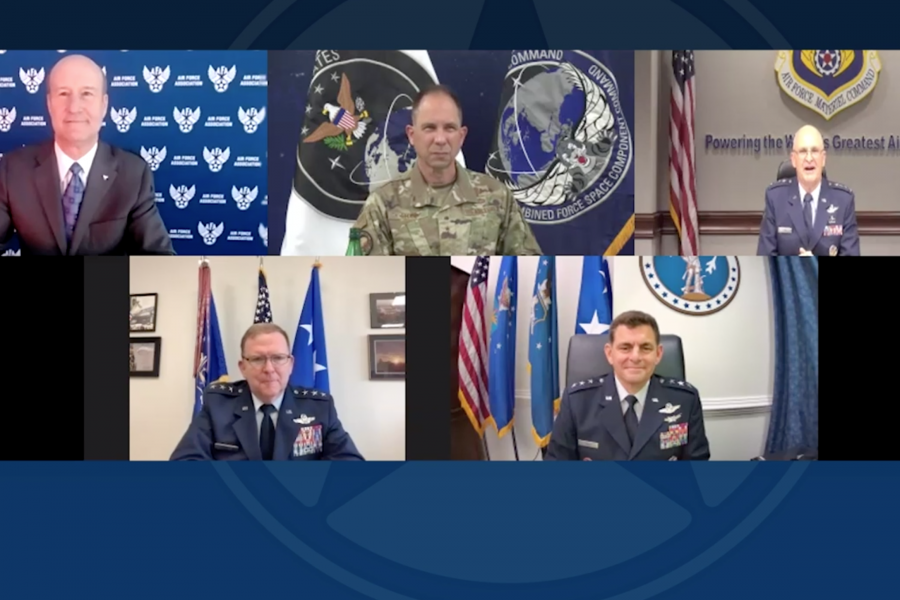The first week of March, Air Force Materiel Command boss Gen. Arnold W. Bunch Jr. attended a senior leader conference awards banquet, and he and the other attendees were “high-fiving, we’re shaking hands, we’re hugging, we’re jamming together to [take] selfies.” Two weeks later, about a dozen airmen wanted a photo to commemorate a C-130 coming off the depot line at Robins Air Force Base, Ga., and “we almost needed a wide-angle lens to be able to take a picture with everybody spaced out.”
Bunch now keeps a photo from each event, as “a stark reminder of just how much our world changed in a really short timeframe.”
The COVID-19 pandemic has changed the way people around the world work, travel, and live. The U.S. Air Force and U.S. Space Force are no different. When the threat of the virus became clear, leaders throughout the Department of the Air Force sprung into action to change how—and where—work is done, and there’s no going back now, panelists said Sept. 16 at AFA’s virtual Air, Space & Cyber Conference.
“As we started this, I looked around the office for the book on how to operate the command in a pandemic, and, surprise surprise, there wasn’t one,” Bunch said. “We just knew that we were going to have to” figure it out, making adjustments along the way, “because of what we need to do to support the nation.”
Army Maj. Gen. John E. Shaw, combined force space component commander for U.S. Space Force and commander of Space Force’s Space Operations Command, said that even before the pandemic, Space Force Chief Gen. John W. “Jay” Raymond and the service’s senior enlisted adviser, Chief Master Sgt. Roger A. Towberman, had been talking about the fact that Space Force “is a digital force” and was “going to be the first branch in our military to really embrace digital technology.”
Now, he said, “I think we can all say, everybody listening here today can say, that you experienced a hyperspace jump in your digital proficiency during COVID. That’s a silver lining, perhaps, for each of us personally, and also for us as a nation.”
Still, he said, there was not a one-size-fits-all solution to keep COVID-19 from impacting operations.
The needs and concerns at Thule Air Base, Greenland, are different from those of Naval Support Facility Diego Garcia in the Indian Ocean, he said, and both are different than Buckley Air Force Base, Colo. Cheyenne Mountain Air Force Station, Colo., is “really a big ship under a mountain,” so as reports emerged about COVID-19 ravaging cruise ships, “it didn’t take long … for us to realize, hey, if something took hold inside the mountain, that could be really bad,” for Space Command, the Missile Warning Center, U.S. Northern Command, and U.S. Strategic Command, he said.
But “in all instances,” Shaw said, “Operations never missed a beat.”
Similarly, Bunch said AFMC was able to find solutions “to keep hypersonic testing on track, we’ve been able to keep our F-35 testing on track. And one that we did in the middle of the pandemic, was we did climatic lab testing for the [HH-60W] Jolly Green [II].”
Lt. Gen. Richard W. Scobee, chief of the Air Force Reserve, said Reserve Command was “already preparing to have a force that had more flexibility to participate using more of a virtual environment,” but the pandemic hastened that work. At the same time, Reservists activated to support efforts to fight COVID-19.
Leaders quickly realized that command teams should be making decisions about when to return to work and restart training, because “they have the clearest picture of what their population is and the mission in the local area.”
Now, Scobee said, “We do not intend to revert back to the way we were doing things before … we’re going to fully embrace some of these changes. And one of those is a culture of telework. We’ve determined we can do things remotely and be successful.”
Lt. Gen. Michael A. Loh, director of the Air National Guard, said he also pushed authority to make many decisions “down to the lowest level, down to the squadron commanders and below, the command teams, the first sergeants, our senior enlisted leaders. I mean, those folks were making the mission happen. It takes about five people to change an F-16 engine, and those five people are not socially distanced.”
Loh said leaders asked those Airmen what they needed, and then “gave them all the authority, and not just accountability.”
At AFMC, “we weren’t where we needed to be with telework” when the pandemic started, Bunch said. “We weren’t able to keep people online, and we weren’t be able to get the mission done.” However, those issues have now been fixed, he added, and as a result, “we won’t go back.”
Shaw noted that space operations “have always been virtual, to some extent,” but said he believes “we will emerge from this a much more proficient digital society and digital Department of Defense,” with Space Force, in particular, benefitting from the lessons learned.
Still, he warned: “The next pandemic will not look like COVID. The transmission rates, the infection rates and the methodology, the morbidity and mortality rates will not be the same. So we have to ensure, and I’m hoping that we have learned enough from COVID, that we learn the right lessons for the next pandemic and that we’re ready for it.”
